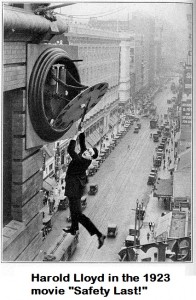Back in May, I promised to discuss suspense, and I’ve kept you in it long enough. First, in defining the term, we learn that it means (1) the state of being suspended, (2) a mental uncertainty or anxiety, and (3) the state of being undecided or doubtful.
 Definitions (2) and (3) may seem to have the most significance for us here, but I like the image of definition (1). Imagine a character who is physically suspended over the ground at some great height. There is a danger he may fall and get hurt or killed. Neither the reader nor the character knows if the fall will happen or not. However, at the moment there exists both the danger that he will fall and the hope that he will either not fall or that the fall will somehow not harm him.
Definitions (2) and (3) may seem to have the most significance for us here, but I like the image of definition (1). Imagine a character who is physically suspended over the ground at some great height. There is a danger he may fall and get hurt or killed. Neither the reader nor the character knows if the fall will happen or not. However, at the moment there exists both the danger that he will fall and the hope that he will either not fall or that the fall will somehow not harm him.
The danger leads to the character feeling fear. If the character has been previously introduced to the reader as a sympathetic one and the reader has come to care about him, then the reader will share both the uncertainty and the character’s fear of the fall.
The danger need not involve falling from a height, of course, but can be any real danger to the character, including emotional danger. The feeling of suspense arises from not knowing whether the outcome will be good or bad and the feeling is more intense if the reader sympathizes with or pities the character.
In his book Poetics, Aristotle explained suspense the same way we have, with the concepts of a looming danger, a ray of hope, an uncertainty of outcome, and the audience’s (reader’s) caring about the character. We’re not exactly plowing new ground here; suspense is a timeless idea.
We can bring in definition (3) of the word “suspense” by giving our character a choice of actions to take. He does not know which choice will make the danger greater or which will cause a hoped-for positive outcome. Since he does not know, he is uncertain and doubtful about which choice to make.
Most fiction involves suspense to some degree, but so-called suspense novels are chock full of that emotion. What techniques does a writer of such novels use to ratchet up suspense?
- Create in the reader’s mind an intense sympathy for the character. Establish the character as real, human, and vulnerable.
- Introduce a danger with high stakes. It must be plausible and full of dire consequences for the character should the danger be realized.
- Set up the situation so the negative outcome is far more likely than the positive one. Make the odds nearly (but not) impossible. Ensure Aristotle’s “ray of hope” is laser-thin.
- Give the character a set of choices that all seem bad.
- Provide the reader with knowledge of some fact the character doesn’t know, perhaps some fact about one or more of the choices being faced. You might think this would lessen uncertainty and doubt, and thus reduce suspense. But note that it doesn’t lessen the character’s uncertainty and it actually increases the reader’s sympathy for the character; it makes the reader want to shout, “No! Don’t do that!”
- Introduce a time limit, a race against the clock. This forces the character to make one of the choices without enough time to fully analyze chances and consequences.
- Conclude each chapter (or short story break) with some enticement to keep reading.
- Bring in unexpected complications that worsen the danger, tighten the timeline, or narrow the ray of hope still further.
- Keep the tension high for as long as possible. In other words, delay the events that will resolve the suspenseful situation as long as you can, but stop short of the point where the reader gets bored and stops caring.
Do you think you can write in a suspenseful way? What difficulties do you see in doing so? I welcome comments on the topic. And for those of you wondering who wrote this blog entry, you may call me…I’m known as…(suspense building)…wait for it…
Poseidon’s Scribe
